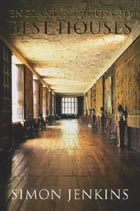Book Review: England's Thousand Best Houses
Clive Aslet applauds the perfect guide to England's thousand best houses by Simon Jenkins.


How does he do it? No sooner does Simon Jenkins lay down his pen after visiting 1,000 churches, than he is in the car again, on the trail of England's Thousand Best Houses. The result is an astonishing achievement, its elegant text giving no hint as to the exhaustion which must sometimes have overcome him. No one could doubt that he actually did make the visits. Entries are shot through with personal observations, as he encounters owners sunning themselves on benches or their young children making havoc of the kitchen garden.
As you would expect from one of The Times's star columnists, opinions are liberally shared. 'I wish at least some English castles could be left looking as they did in old prints,' he laments. Inside houses, he frowns on untidiness. But despite the occasional prejudice, he rarely misses the essential spirit which makes a place tick.
All that having been said, houses are not churches. For England's Thousand Best Churches, the field was wide open, the old habit of 'church crawling' having been virtually forgotten since Sir John Betjeman's day. Houses open to the public tend to be better known. There are also considerably fewer of them. England's Thousand Best Houses should strictly have been called The Thousand Domestic Buildings of Any Description Which can be Visited. In order to reach the necessary target, Mr Jenkins ropes in not just conventional houses but gaols, workhouses, ruins, archaeological sites, Oxford and Cambridge Colleges and, in one case, an inn.
The result is less conceptually satisfying than the churches book. On the other hand, Mr Jenkins introduces the reader to a lot of buildings-from pilgrim's hospitals to railwaymen's cottages-that he is unlikely to know. For my own part, I cannot wait to visit them.
Mr Jenkins tells a good story. Characters such as Crump Dutton, the hunchback and gambler who built Lodge Park as a grandstand for his coursing dogs in Gloucestershire, jump off the page. I did not know before that John Milton slept in the study of his Chilterns cottage where he escaped the Great Plague: he could not see to go up the stairs. But the story as often as not concerns the 'saints' of owners who have either rescued houses, or kept them going.
There are plenty from the Edwardian period, to whom we owe the survival of many West Country manor houses, but even more from our own. Tourism helps, of course. We learn of more than one house whose history has been skewed to emphasise a sometimes tenuous American connection: lottery money has turned Sulgrave Manor, Northamptonshire, into a 'George Washington theme park'. Mr Jenkins is rightly infuriated when he finds houses interpreted for children, but not adults. He does not care much for waxworks, even less for actors in costume, although is surprisingly indulgent towards the 'button-bustin' feasting and merriment' on offer at the Old Manor House, West Bromwich.
The book has its moments of intimacy, too. Mr Jenkins reveals that he and his wife spent the first night of their honeymoon in Henry James's Lamb House in Rye, being 'guided upstairs by candles that had been left out for us'. That was a few years ago, presumably. Fortunately, Lamb House is one of many places in this cornucopia of a book that do not change.
Sign up for the Country Life Newsletter
Exquisite houses, the beauty of Nature, and how to get the most from your life, straight to your inbox.
Country Life is unlike any other magazine: the only glossy weekly on the newsstand and the only magazine that has been guest-edited by HRH The King not once, but twice. It is a celebration of modern rural life and all its diverse joys and pleasures — that was first published in Queen Victoria's Diamond Jubilee year. Our eclectic mixture of witty and informative content — from the most up-to-date property news and commentary and a coveted glimpse inside some of the UK's best houses and gardens, to gardening, the arts and interior design, written by experts in their field — still cannot be found in print or online, anywhere else.
-
 Six rural properties with space, charm and endless views, as seen in Country Life
Six rural properties with space, charm and endless views, as seen in Country LifeWe take a look at some of the best houses to come to the market via Country Life in the past week.
By Toby Keel
-
 Exploring the countryside is essential for our wellbeing, but Right to Roam is going backwards
Exploring the countryside is essential for our wellbeing, but Right to Roam is going backwardsCampaigners in England often point to Scotland as an example of how brilliantly Right to Roam works, but it's not all it's cracked up to be, says Patrick Galbraith.
By Patrick Galbraith